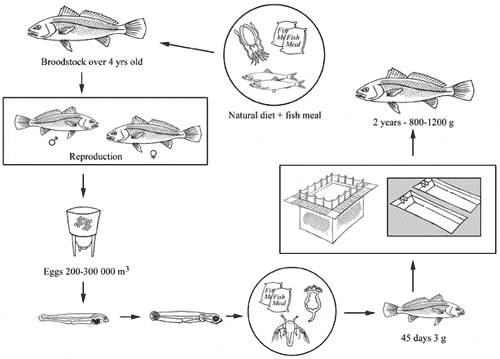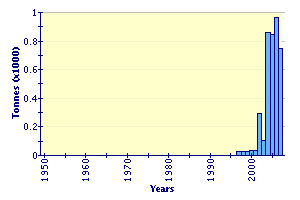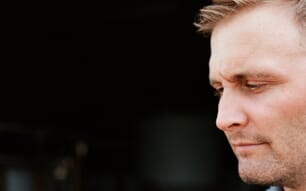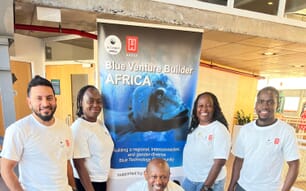Biological features
Relatively big head with elongated body. Mouth in terminal position without barbils. Eyes quite small. Lateral line evident, extending onto caudal fin. Second dorsal fin much longer than first. Anal fin has a first short spiny ray and a second very thin one. Several branched appendices are present in the gas bladder, which can vibrate producing a typical 'grunt'. Very large otoliths. Body colour silver-grey, with bronze traits dorsally. Fin base reddish brown and mouth cavity yellow-gold. Post-mortem colour brown. Reaches up to 2 m in length and 50 kg in weight.
Profile
Historical background

Argyrosomus regius
The history of meagre in aquaculture is quite recent. First trials with wild broodstock were conducted in the south of France, where some of the Sciaenidae family were thought to have good aquaculture potential. Starting from 1996, fry production has been very limited, with a single hatchery operating in France. In fact the rearing protocol of this species is still relatively unknown, and has not yet been made public. The first commercial production (in France) was recorded in 1997. Since then production has expanded slowly in nearby regions, especially on the Tyrrhenian side of the Italian coast, and in Corsica. The adult meagre market is now slowly expanding, especially in Italy; this could promote fry production in the future, as well as research on fry and juvenile production. Commercial production in Italy was first reported to FAO only in 2002.
Main producer countries

Main producer countries of Argyrosomus regius (FAO Fishery Statistics, 2006)
Habitat and biology
Meagre are widespread all over the Mediterranean Sea, although not very common around Italy and Greece; the biggest fish are found along the coast of West Africa. In Senegal, in the bay of Dakar seems to be the southern limit of the species; big schools of meagre are found around wrecked ships that were sunk to create habitats for several commercial species. They can grow up to 2 m and reach >50 kg. Growth is mainly achieved during summer; feeding activity is substantially reduced when sea temperatures drop below 13-15 ºC.
During reproduction migration, adult meagre approach the coast line in mid-April. They penetrate estuaries at the end of May in order to spawn (anadromous migration). During the spawning season, males produce a typical deep sound, by pushing their abdominal muscles against the gas bladder. From mid-June until the end of July they leave estuaries to feed along the coast. They remain in shallow water until the beginning of autumn. During winter, maigres return to deeper water.
Juveniles (age 0) leave the nursing areas (estuaries) at the end of summer and migrate to coastal waters (from 20-40 m) to spend the winter. Starting from mid-May they return to their estuarine feeding areas.Water temperature is the most important factor that determines the trophic migration and reproduction of meagre. The arrival of adults and the departure of juveniles from estuaries (age classes 0, 1 and 2) occurs in May and October when water temperature is close to 13-14 ºC. The best temperature for the growth of meagre is between 17-21 ºC, with an acceptable range of 14-23 ºC. A 1.2 m female produces about 800 000 eggs, spawning occurs at 17-22 ºC.Fertilized eggs measure 990 µm in diameter. After 30 hours the lipid droplet is totally absorbed. At 96 hours the vitellin sac is almost consumed and the mouth is open. Benthic juveniles of 3.7 cm have been captured, indicating that pelagic life is quite short. Larvae need temperatures above 20-21 ºC in order to feed.Juveniles (age 1) eat small demersal fish and crustaceans (mysids and shrimp). When they reach 30-40 cm, they feed on pelagic fish and cephalopods.
Production
Production cycle

Production cycle of Argyrosomus regius
Production systems
Farmed meagre come from intensive production, conducted both in land-based tanks and cages. Production facilities are few and mainly distributed in southern France (Camargue, Cannes, and Corsica) and Italy (La Spezia and Orbetello).
Seed supply
At present (2004), the supply of seed still comes from a single hatchery in the south of France. There are probably two main reasons. Firstly, market demand is not great enough to justify greater fingerling production; secondly market demand is insufficient to persuade other hatcheries to develop their own production protocol for this species.
Nursery
A specific nursery phase is not compulsory for meagre. However, fingerlings are normally delivered between 3 g and 20 g and are stocked into small ponds or cages (about 80-100 m³) at 300-350 fish/m³. Usually they are kept for 3 months until they reach 100 g. During this phase survival rate is around 80 percent.
Ongrowing techniques
Ongrowing techniques are similar to those used for European seabass and gilthead seabream.
In land-based farms production is mainly achieved in circular or rectangular tanks with a water depth of 1 m and a volume of 500 m³; the tanks are usually covered with PVC cloth to avoid skin abrasions, especially where they are concrete. The tanks may be circular or rectangular and are stocked with 100 g fish at about 50/m³.
At normal stocking density (50/m³) meagre reach 800-1 200 g in less than 24 months. Very often they are fed until they reach 2 000-3 000 g, a size that is more suitable for fillets or slices.
Nowadays meagre is mainly farmed in the sea, using circular or square surface cages of 500-1 000 m³. More recently, submerged cages have also successfully been used; these 2 000 m³ cages are submerged at 10-20 m, and a low stocking density (10-15/m³) is used. Good results have been obtained in terms of growth rate and FCR.
Feed supply
Feed is supplied by all the major aquafeed producers. Meagre feed is similar to that used for other Mediterranean marine species. An extruded feed with 45-48 percent protein and up to 20-24 percent lipid is used. In land-based farms 2 to 3 meals per day are presented; in sea cages a single daily meal is often normal. In sea cages, where oxygen levels are not normally problematic, meagre can be fed with 1-2 percent bw/day, especially during the first year, when water temperatures are above 18 ºC. An FCR of about 1.7:1 has been achieved; in some cases (in large sea cages with a stocking density below 50 m³), trails are showing even better FCRs.
Handling and processing
Even though meagre are quite resistant to handling, care is still needed. Scales can easily be lost and tails damaged. Their eyes are also quite delicate and being hit may cause blindness.
Sometimes meagre are gutted and/or filleted soon after harvesting. Studies are being conducted on the best harvesting protocols to optimize the shelf life of the final product.
Production costs
Since the number of production units is low, cost comparisons are difficult to make. In land-based systems costs depend mainly upon the size of the farm. However, in cage culture the major expense is the cost of juveniles; currently these must be bought in the South of France. Generally, feed represents the other major cost during grow-out but it is lower than other marine fish species, since the FCR for meagre is generally better.
Diseases and control measures
There are still few data regarding diseases of this species. It seems that they are quite resistant to the bacterial diseases experienced by other marine species. There have been cases of parasitism (such as Amyloodinium sp.). Prevention is mainly achieved by controlling density and water quality.
In some cases antibiotics and other pharmaceuticals have been used in treatment but their inclusion in this table does not imply an FAO recommendation.
| DISEASE | AGENT | TYPE | SYNDROME | MEASURES |
|---|---|---|---|---|
| Vibriosis | Vibrio anguillarum | Bacterium | Fins and areas around vent and mouth become reddened; loss of appetite | Antibiotic in feed |
| Oodiniasis | Amyloodinium ocellatum | Protozoan parasite | Protozoan attach to gills, producing irritation, asphyxia and hypermucosis | Formalin; copper sulphate |
| Fluke | Gyrodactylus sp. | Trematodal parasite | Parasites attached to fins and gills | Formalin |
Suppliers of pathology expertise
Each producing country has a government authority responsible for upholding statutory requirements, such as licensing, discharge control, notifiable disease control, etc. Contact the relevant government aquaculture/fisheries/animal health departments. The supply of diagnostic services may be carried out by government departments or private organizations or individuals.
Statistics
Production statistics
Global aquaculture production of Argyrosomus regius
(FAO Fishery Statistic)

Production of farmed meagre is very limited so far and is confined to the Mediterranean Basin (southern France, Corsica and Italy). Reported production in 2002 was 231 tonnes (50 percent from Italian cages; 7 percent from Italian tanks; 40 percent from French cages; 3 percent from French tanks) with a value of USD 1.55 million.
Market and trade
The mean market price of meagre coming from the capture fisheries varied little between 1985 and 1991 (EUR 2-4/kg) but it increased from 1992 (EUR 4.5-6/kg). In 1996 prices dropped to EUR 4-5/kg, due to the increased availability from large Mediterranean catches, and remained relatively stable until 1998. Following low production in 1999, prices suddenly increased to EUR 6/kg. Since then, there has been an increase in demand for fish weighing more than 2 kg, which is sold between EUR 7-12/kg. Southern France and Italy are the most important markets for this species (at 1-3 kg); nowadays the supply comes from both capture fisheries and aquaculture. Since 2002, producers are trying to differentiate between meagre products: smaller fish (600 g to 1 kg) are sold whole or filleted, while bigger fish (1 kg to 3-5 kg) are sliced or filleted and smoked. The smoking procedure is very recent and is giving good results. Meagre meat quality is considered very good, due to its very high content of polyunsaturated fatty acids.
Status and trends
Recently a research project on meagre funded by the Italian Regional Agency for the Development and Innovation of Agriculture (ARSIA) has investigated several aspects, such as reproduction, grow-out and quality issues. Other projects are forecast, focussing on reproduction and juvenile production protocols. Economic and technical comparisons of land-based versus cage culture for meagre production are underway. Meagre are included in shelf-life studies.
Meagre has a number of attractive features:
- It is a particularly lean fish, even when grown intensively and receiving the high fat diets that produce high quality marketable products.
- It has a high dressing percentage, low adiposity, healthy muscular lipid content, and long shelf life.
- It reaches relatively large commercial sizes quite rapidly, showing promise for the processing industry; this could create a different market niche for meagre, compared to seabass and seabream.
A small but steady increase in the production of farmed meagre is expected in the next few years, especially in central Italy (southern Tuscany area).
Main issues
Two major factors need to be addressed if meagre farming is to expand significantly:
- Juvenile quality cannot yet be controlled, since there is currently only one source.
- Demand is low, because meagre products are not yet sufficiently well-known to the public. Meagre is generally sold by farms that also produce seabass and seabream, which (so far) are generally more appreciated.
Responsible aquaculture practices
Like the farming of other marine species, meagre culture has some negative impacts on the environment (such as potential pollution and disease transfer), due to the intensity of its production. However, fish escapes from cages are not considered a major problem because meagre is endemic in the Mediterranean basin (recently a few hundred meagre escaped from a cage in Tuscany but all were collected nearby within a few days by the local trawling fleet, indicating that this species does not move very fast and is easily recaptured; this reduces the risk of altering the existing fish community structure).
November 2009





